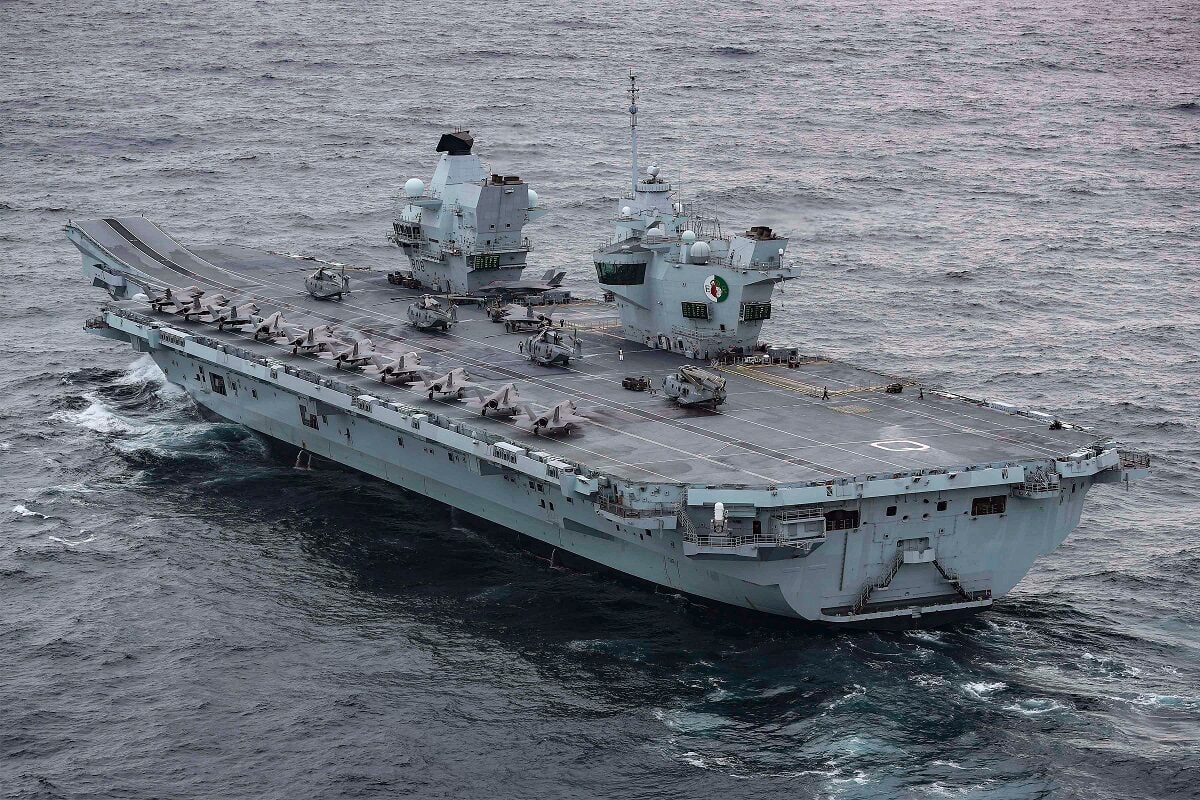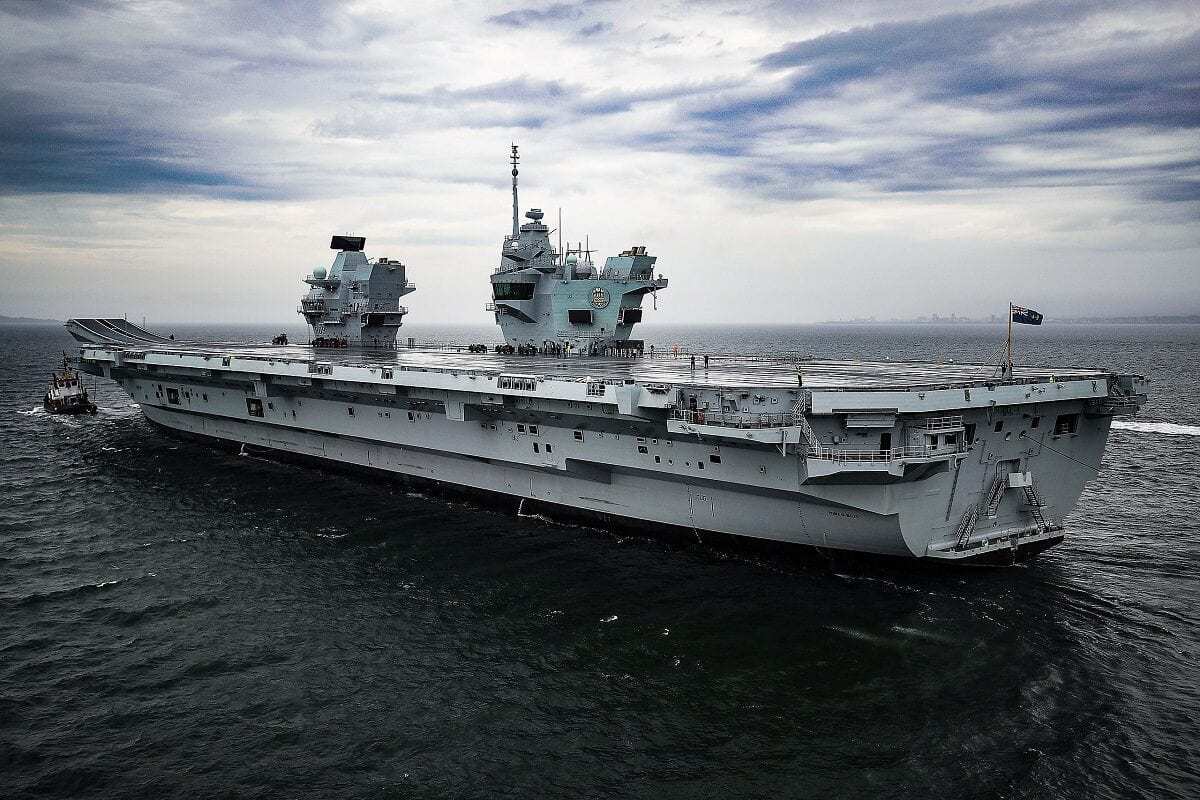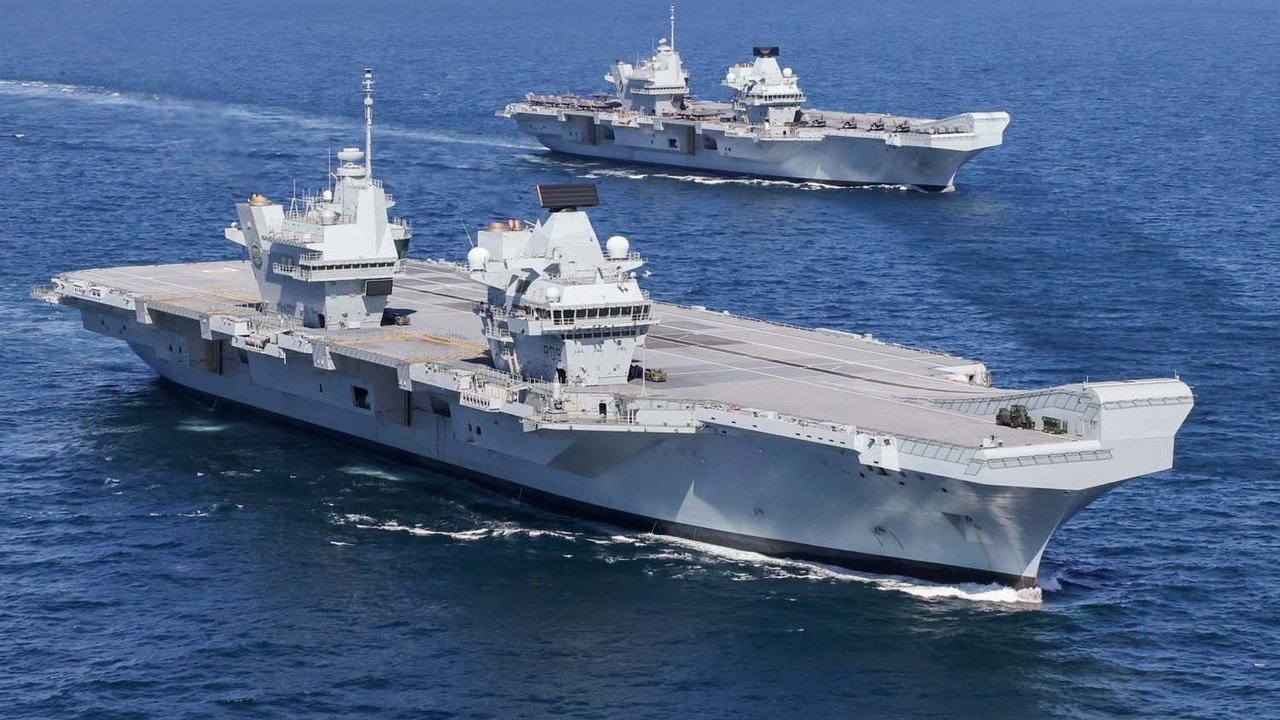The Royal Navy has aircraft carriers again. But should they?
ABOARD HMS QUEEN ELIZABETH — The British Royal Navy has spent five years getting used to operating aircraft carriers again after a brief but notable absence of carriers from the fleet.
The Royal Navy now has two carriers in service. Its flagship, HMS Queen Elizabeth, was commissioned in 2017 and is preparing to deploy with the UK-led Joint Expeditionary Force. But HMS Prince of Wales, commissioned in 2019, is now in a dry dock awaiting what may be months of repairs after an “unusual fault” in one of its propeller shafts, leaving its future less certain.

The full United Kingdom (UK) Carrier Strike Group (CSG) assembled at sea on 04 October, 2020. The (CSG) is led by Her Majesty’s Ship Queen Elizabeth and includes flotilla of destroyers and frigates from the UK, the Netherlands, the USS The Sullivans, and 15 F-35B Lightning II’s from Marine Fighter Attack Squadron 211 and the UK’s 617 Squadron. The Navy-Marine Corps team is humbled and proud to represent the United States and serve alongside our United Kingdom counterparts.
(Royal Navy Photo by LPhot Alker)

Britain’s newest aircraft carrier, Prince of Wales.
HMS Queen Elizabeth’s commissioning came three years after the retirement of HMS Illustrious and ended the Royal Navy’s longest period without a carrier in service in nearly a century.
A year later, two F-35Bs landed on the ship, becoming the first fixed-wing jets to land on a British carrier since the UK retired its Harrier jets in 2010 and marking “a rebirth of our power to strike decisively from the seas anywhere in the world,” the British defense secretary said at the time.
In the years between Illustrious’ retirement and the commissioning of HMS Queen Elizabeth, British sailors and airmen continued training for carrier operations, preparing to fly the F-35B from a ship designed with the jet in mind.
The UK began a “long-lead skills program” in 2010, sending 300 aircraft handlers, aircraft controllers, and aircrew to embed with US Navy and Marine Corps units, said Cmdr. Neil Twigg, air operations commander aboard HMS Queen Elizabeth.
“I flew F/A-18s with the US Navy for three years, embarked on US carriers, so that when I came back to the UK, I then helped to learn how to integrate the F-35 onto this ship,” Twigg told Insider as the carrier visited New York City to host the Atlantic Future Forum on September 29.
The Royal Navy’s “subject-matter” expertise in carrier operations shrunk but wasn’t lost, Twigg said.
“We always had people there, but we didn’t have the big, corporate knowledge during that 10-year period” between the departure of the Harriers and the beginning of workups with the new carrier and jets, Twigg added.
HMS Queen Elizabeth and its jets are more advanced their predecessors, but the Royal Navy has experience with short-takeoff-and-vertical-landing operations and is “really comfortable” conducting them, Cmdr. Sam Law said alongside Twigg during an interview in the ship’s hangar bay.
“So, yes, there was a bit of a hiatus,” added Law, the carrier’s logistics commander, “but it’s something we’re used to.”
Not just a floating airfield
Following exercises around the UK — including the first time British jets had fired missiles at sea in 15 years — HMS Queen Elizabeth departed on its maiden deployment in May 2021.
The seven-month mission took the ships as far as Guam, with visits to 40 countries and exercises with dozens of militaries.
The carrier embarked with 18 F-35Bs — 10 from the US Marine Corps and eight from the Royal Air Force — which the Royal Navy touted as “the largest contingent” of fifth-generation jets “ever seen at sea.” It required “a pretty sizable” logistical chain to sustain the 1,700 sailors and aircrew, the jets, and the ship itself, Law said.
“You can imagine the number of rations we put across the counter every day,” Law added. “I have 97 chefs doing the feeding, and I’ve got a stock inventory on board, not food but spare parts [worth] about 4.5 billion pounds.”
The strike group included RFA Tidespring, a replenishment tanker, and RFA Fort Victoria, a solid-support ship carrying food and ammunition. The UK plans to build three more solid-support ships, and the deployment “absolutely confirmed” the need for them, Law said.
The mission was “made slightly more complex” by the F-35B’s unique logistical requirements, and a Lockheed Martin field service representative was aboard to assist, Law added.
The US and UK worked closely together to prepare the jets for deployment, and while at sea their squadrons not only shared spare parts but exchanged pilots.
The British aircrews began “synthetic training” in the US in 2020 and then returned to the UK, where both units — the Royal Air Force’s No. 617 Squadron and US Marine Fighter Attack Squadron 211 — spent four weeks ashore and four weeks at sea, “working side by side” Twigg said.
Upon embarking in April 2021, he added, “it was like we’d already done the training, done the workups, and then we were able to deploy.”
While US Marines use the F-35B slightly differently, focusing on littoral operations, their aircraft and squadrons were “interchangeable,” Twigg said. “If a UK aircraft broke, couldn’t start for whatever reason, a US aircraft and a US pilot would go and be his wingman instead, so that’s the sort of integration that we got to.”
The British F-35Bs had qualified for all their missions from shore in 2018, and the deployment was meant to test their ability to do them from the carrier and in conjunction with other ships and aircraft.
“It’s not just about being a floating airfield,” Twigg said. “It’s got to integrate with the ship, with all the other squadrons, and then the rest of the strike group, and everywhere we go. So that’s what we were trying to prove.”
Flight operations were aided by the “versatility” of the carrier’s short-takeoff-and-vertical-landing design, which allows aircraft to take off and land simultaneously. Without catapults and arresting gear, Twigg added, “a lot of the burden” of launch and recovery is on the aircraft rather than the ship, and fewer people are needed on the deck.
“I have a team of just 27 on the flight deck” compared to about 200 on the deck of a US Nimitz-class carrier, Twigg said. “It’s a lot quieter, and there’s less moving parts of the deck itself.”
‘Big lumps of metal’
HMS Queen Elizabeth’s maiden deployment was an international endeavor in many ways. In addition to US jets, the strike group included a US Navy destroyer and a Dutch navy frigate.
The multinational makeup was “about getting beyond interoperability to interchangeability” and to find “would the captain of this ship feel comfortable with a foreign partner-nation defending his ship?” Law said.
The carrier and its escorts conducted dozens of exercises with partners and allies, including a first-of-its-kind cross-deck landing drill with a US amphibious assault ship and with Italian F-35Bs.
The ability of US, UK, and Italian F-35Bs to operate from each other’s ships “offers tactical agility and strategic advantage to NATO,” the strike group commander, Commodore Steve Moorhouse, said last year.
The attention was not all friendly. While conducting airstrikes against ISIS targets in Iraq, the carrier’s jets encountered Russian aircraft operating from Syria, leading to “cat-and-mouse posturing,” a British officer said at the time.
In the Pacific, the strike group’s ships and helicopters kept track of Chinese submarines to allow the carrier to avoid them, Moorhouse said last year.
Twigg wouldn’t comment on those interactions but said British pilots were prepared for incoming threats. “We went round very confidently,” he told Insider. “We could defend ourselves if it was necessary.”
Nor were the milestones all positive. While in the Mediterranean in mid-November, a British F-35B crashed at sea. The pilot was recovered, but the lost jet was one of the newest ones in the fleet.
The carrier and its crew returned to the UK in December and spent four months repairing the ship, updating procedures, and training new crew.
“Mainly our focus was getting them trained up,” Twigg said of the new crew members. “They were civilians last year and now they’re serving aboard, so it was a lot of training that we’ve done this year.”
The carrier has spent much of 2022 on very-high readiness status, ready to deploy on short notice if needed — and it was needed in late August, when its sister ship, HMS Prince of Wales, broke down as it departed for New York City.
HMS Prince of Wales was supposed to host the forum as part of a longer deployment to North America, but HMS Queen Elizabeth was instead sent to New York, which turned out to be a relatively easy task.
Prince of Wales handed over the three helicopters it had prepared for the event. “I had to do a day of training with my team with the helicopters and we were good to go flying,” Twigg said.
Other material just had to be moved from one carrier to the other. “Because we have adjacent berths back in Portsmouth, it was literally just crane it all off, down the jetty, back on here, and off we go,” Law said.
Moorhouse said in September that an inspection found an “extremely unusual fault” in Prince of Wales’ starboard propeller shaft and that there was “significant damage to the shaft and the propeller and some superficial damage to the rudder.”
The propeller was removed and the carrier taken to the shipyard where it was built, where it entered a dry dock in mid-October.
Adm. Ben Key, first sea lord and chief of the British naval staff, praised HMS Queen Elizabeth’s crew for taking on host duties “with considerable alacrity” and called the damage to HMS Prince of Wales “a great shame.”
But the carrier’s future wouldn’t be clear until it was in a dry dock and “we can actually inspect properly what has gone wrong,” Key told reporters aboard HMS Queen Elizabeth on September 29. “These are big lumps of metal that have failed, so this is not necessarily going to be a quick fix.”
The death of Queen Elizabeth II shortly after her namesake carrier was assigned to host the forum “brought an additional poignancy” to the event, Key added, “but in the grand scheme of things, I wish it was Prince of Wales here, because that would mean that she hadn’t got a problem with her starboard shaft, frankly.”

